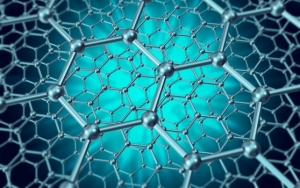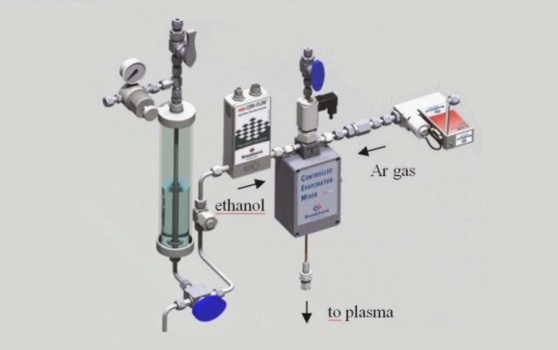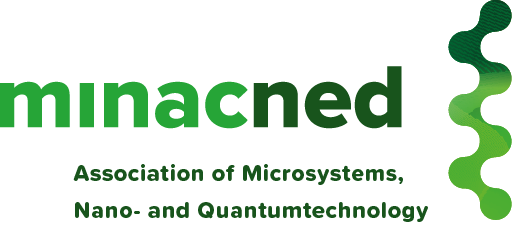In een door NWO gesteunde publiek-private samenwerking werkten meetapparatuurspecialisten Bronkhorst en Krohne samen met de technische universiteiten van Delft en Twente om debietmeters naar de volgende generatie te brengen. Hun doel: nieuwe en innovatieve meters ontwikkelen die realtime inzicht en analyse van stromende media kunnen bieden, allemaal zonder de stroom te hoeven onderbreken.
Auteur: Collin Arocho, Bits & Chips
Foto: An ultrasonic flow meter installed on a customer setup. Credit: Bronkhorst
In all high tech industrie wordt gewerkt aan manieren om gegevens te verzamelen en analyses te gebruiken om het meeste uit hun producten te halen. Volgens de experts van Bronkhorst High-Tech en Krohne Altometer beweegt de markt voor stroommetingen onvermijdelijk in dezelfde richting. “We willen meer kunnen meten dan alleen de mediumstroom door een buis. We willen het debiet en andere parameters zoals dichtheid, viscositeit en andere betekenisvolle grootheden meten ”, legt Joost Lötters, wetenschappelijk medewerker bij Bronkhorst, uit.
In de industrie heeft Lötters zich meer dan twintig jaar gericht op het ontwikkelen van massastroommeters die worden gebruikt voor het meten en regelen van de stroom van vloeistof en gas voor een verscheidenheid aan toepassingen in laboratoria, machines, industriële en gevaarlijke gebieden. Naast deze “dagbaan” bij Bronkhorst is hij parttime hoogleraar microfluïdische handlingsystemen aan de technische universiteiten (TU’s) in zowel Delft als Twente. Dit betekent dat hij als het gaat om kennis van de markt voor meetapparatuur, de eisen van de klant goed begrijpt, evenals de technologische innovaties die nodig zijn in het domein.
In 2014 kreeg Lötters lucht van het stimuleringsprogramma voor partnerschapsonderzoek via de Nederlandse Onderzoeksraad (NWO), waarbij de raad fondsen, van 3-10 miljoen euro, zou matchen om publiek-private samenwerkingsprojecten te ondersteunen. Met voorkennis van de onderzoeksmogelijkheden bij de TU’s, nam hij contact op met zijn collega’s bij Krohne om het ontwikkelingsproces van de volgende generatie flowmeters te begeleiden in een programma genaamd ‘Flow +’ – gericht op het verzamelen en benutten van waardevolle gegevens om klanten meer te geven inzicht en kosten verlagen.
Onderzoekers werden uitgenodigd om voorstellen in te dienen over hoe hun idee in het programma zou passen. “We hebben de voorstellen bekeken door de lens van de technologiegereedheidsniveaus van NASA”, zegt André Boer, de algemeen directeur van Krohne. “Universiteiten werken doorgaans tot niveau 3 of 4, de fase van een proof-of-concept of functioneel model. Voor Flow + wilden we iets geavanceerder: we wilden naar TRL 6, een volledig functioneel en verplaatsbaar model, met de ambitie om het helemaal naar niveau 9 te brengen – missiesucces. We wilden onze expertise gebruiken om de onderzoekers te helpen de kloof te overbruggen en om uit de eerste hand ervaring op te doen uit de industrie, maar ook om onze producten op de markt te krijgen. ”
Ultrasonic
De medewerkers ontvingen in totaal 18 inzendingen van projectontwerpen. Vier voorstellen haalden de laatste ronde. Nu, een paar jaar later, zijn twee van de projecten al gerijpt tot TRL 5. De eerste is een ultrasone flowmeter, afkomstig van de TU Delft. Door dit kleine apparaat aan een buis te klemmen, gebruikt het systeem geluidsgolven om de stroom binnenin te penetreren en te meten, waarbij waardevolle informatie wordt verzameld, zoals de buisdiameter, wanddikte en snelheid van de vloeistof.
“Hiervoor is een zeer intelligent systeem vereist dat zichzelf automatisch kan kalibreren in elke omgeving”, zegt Jankees Hogendoorn, algemeen directeur van Krohne’s New Technologies Group. “In deze opstelling gebruikt het systeem een gefaseerde reeks transducers – een groep sensoren – om de akoestische straal naar specifieke punten en specifieke vlakken te sturen om informatie te verzamelen over een volledige doorsnede van de buis. Hierdoor kunnen we waardevolle gegevens verzamelen en de stroomsnelheid van punt naar punt bepalen zonder dat we in de leiding hoeven te snijden. ” Dit betekent dat eindgebruikers niet alleen nauwkeurigere analytische gegevens ontvangen dan ooit tevoren, maar ook de gezondheid en stabiliteit van pijpleidingen kunnen bewaken terwijl ze een snellere installatie realiseren met minimaal risico op lekken en een verlaging van de totale kosten.
“Ik werk al 35 jaar bij Krohne en we zijn al heel vroeg begonnen met het ontwikkelen van ultrasone flowmeters, omdat dit een van onze grootste wensen was”, zegt algemeen directeur Boer. “Hoewel de ideeën er waren, als het erom ging zo’n tool te produceren – vergeet het maar. De technologie die door de TU Delft wordt ontwikkeld, bestond twintig of dertig jaar geleden nog niet. Mede daarom is deze samenwerking met de TU’s in onze ogen zo’n succes. Via dit programma hebben we gebruik kunnen maken van de laatste ontwikkelingen en hebben we next-gen technologie kunnen realiseren.”
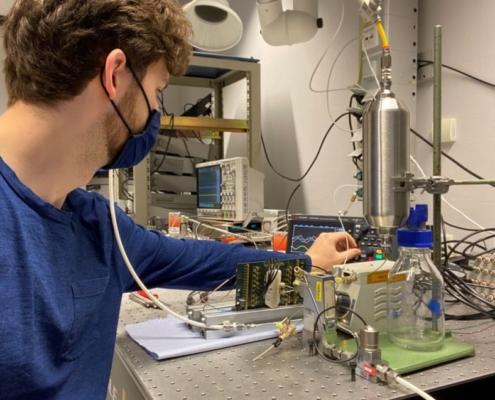
Flow+ PhD student werkt aan de micro Coriolis flow sensor in het lab van de UT. Credit: Flow+
Coriolis
Het tweede van de meest geavanceerde projecten is de thermische geluidsbeperkte Coriolis-stroommeter, een samenwerking tussen de TU’s van Delft en Twente. Een stromingssensor van het Coriolis-type bestaat uit een trillende buis waardoor een vloeistof stroomt. De bewegende massa van de vloeistof resulteert in Coriolis-krachten die inwerken op de trillende buis die kunnen worden gedetecteerd en gebruikt om te bepalen hoeveel stof er per seconde passeert. Bij het meten van gassen kan het echter een beetje lastig zijn vanwege hun lage dichtheid – wat betekent dat er veel druk nodig is om de gasstroom door de buis te duwen.
“Door een inline-oplossing te creëren, kunnen we alle relevante gegevens verzamelen en ervoor zorgen dat de high-throughput-processen in realtime kunnen worden gecontroleerd en aangepast, waardoor de downtime van het systeem wordt beperkt”, legt Lötters uit. “Bij Bronkhorst zijn we gespecialiseerd in het toepassen van het Coriolis-principe voor ultralow liquid flow rates en willen we dit principe voor het meten van gasstromen verbeteren. Maar om dat te doen, moeten we de signaal-ruisverhouding van het apparaat drastisch verbeteren, aangezien de massastromen voor gassen veel lager zijn dan die voor vloeistoffen vanwege hun lagere dichtheden. ”
Om een oplossing te vinden, heeft Twente de rol op zich genomen om de gevoeligheid van de sensoren te verbeteren om lagere stromen te meten. Ondertussen heeft Delft de elektronica die wordt gebruikt om het geluidsniveau te verlagen, verbeterd. Na een paar iteraties van in-house ontwikkeling, is dit team dicht bij het realiseren van een aangepaste ASIC-chip die zal worden geïntegreerd met de verbeterde sensor uit Twente op weg naar een marktwaardig product.
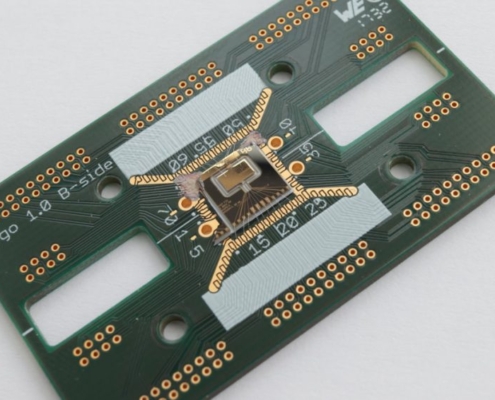
Printplaat met de micro Coriolis flow sensor chip in het midden gemonteerd. Credit: Flow +
Plus
“Het bewijs van de pudding zit in het eten, dus we moeten nog zien hoe het allemaal integreert, maar ik zou deze samenwerking een succes willen noemen”, zegt Lötters. “Er zijn nog steeds enkele vragen die we aanpakken terwijl we door de technologische paraatheidsniveaus gaan. Maar onze visie om ‘flow plus iets anders’ te meten wordt gerealiseerd. Nu meten we de stroom. Vervolgens meten we het debiet plus hoeveelheden zoals dichtheid, viscositeit en warmtecapaciteit. Ten slotte gaan we naar herkenning van gassen, vloeistoffen en bepaling van de samenstelling van gas- en vloeistofmengsels, bijvoorbeeld door een machine-learning component toe te voegen. Het is een stapsgewijs proces, maar dat is de richting die we gaan. ”
In termen van toekomstige toepassing van de Flow + -oplossingen zijn de marktmogelijkheden behoorlijk divers. “Toepassingen van deze systemen variëren van medische oplossingen zoals het meten van de samenstelling van medicijnmengsels van multi-infusie-opstellingen in ziekenhuizen en voedingstoevoer en afvalafvoer in organ-on-a-chip-systemen tot het meten van de energie-inhoud in mengsels van brandstofgassen of onderzoek naar katalysatoren en recepten voor het effectief winnen van olie uit bronnen in de olie- en gasindustrie en vele andere ”, illustreert Lötters. “Al deze industrieën zijn afhankelijk van het monitoren en meten van zowel de stroom in een pijpleiding als de inhoud van de stromende media.”
Flow+
Voor het Flow + project werkten meetapparatuurspecialisten Bronkhorst High-Tech en Krohne Altometer samen met de TU Delft en de Universiteit Twente om de volgende generatie flowmeters te ontwikkelen met verbeterde mogelijkheden voor gegevensverzameling en verhoogde gevoeligheid. Het project wordt mede gefinancierd door Holland High Tech, Topsector HTSM en de Nederlandse Onderzoeksraad (NWO) met een publiekprivate samenwerkingssubsidie voor onderzoek en innovatie.



